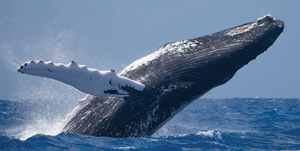Toronto: WhalePower Corporation of Toronto announced that its co-founders have been nominated as finalists for the prestigious European Inventor Award for 2018, based on a design that improves turbine blades by adding a natural feature found on the fins of whales.
 A breaching humpback whale, showing the projections on its fin. Photo credit: Steve Lefkovits, Pacific-Landscapes.com
WhalePower’s patent shows how turbines, compressors, pumps, and fans may be made more efficient, and quiet, by adding bumps called tubercles to the leading edges of their rotating blades. This invention was based on an insight of Dr. Frank Fish, a biologist who studies how animals move through water. Surprised to see bumps on the leading edges of a humpback whale’s flippers, he surmised that they must convey some kind of movement advantage, although, for more than 100 years, engineers had assumed that the leading edges of wings, flippers, or fans must be smooth.
A breaching humpback whale, showing the projections on its fin. Photo credit: Steve Lefkovits, Pacific-Landscapes.com
WhalePower’s patent shows how turbines, compressors, pumps, and fans may be made more efficient, and quiet, by adding bumps called tubercles to the leading edges of their rotating blades. This invention was based on an insight of Dr. Frank Fish, a biologist who studies how animals move through water. Surprised to see bumps on the leading edges of a humpback whale’s flippers, he surmised that they must convey some kind of movement advantage, although, for more than 100 years, engineers had assumed that the leading edges of wings, flippers, or fans must be smooth.
Co-founders Dr. Frank E. Fish and Dr. Philip Watts, an expert on tsunami behavior, ran a simulation that showed that the humpback’s bumps do help make these whales, the size of an average bus, acrobatically agile. Fellow founder Stephen Dewar, an inventor and nature documentary filmmaker interested in whale behavior, read about their work. He proposed that they form a company together to create more sustainable machines by mimicking the humpback’s clever trick – “one refined by over a million years of field tests.” They formed WhalePower and have developed tubercled blades for use on wind turbines, computer fans, and HVLS fans.
The latter are manufactured by licensees in Canada and in China. The production, sale and distribution of these fans employ hundreds. The company reports that its fans quietly cool warehouses, barns, and factories in 38 countries, using 25% less energy to move 20% more air than similar systems without tubercles.
